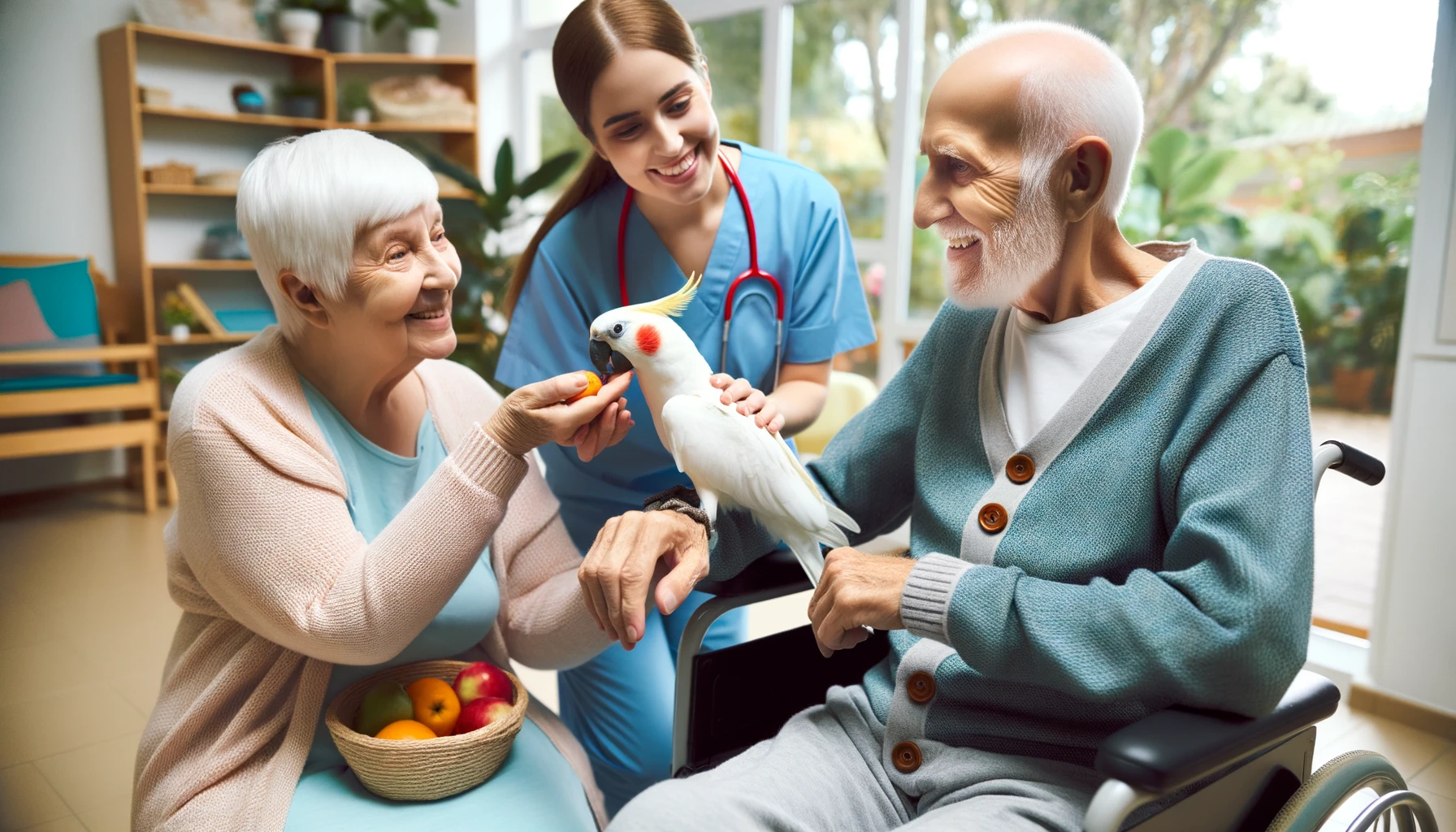Welcome to our introduction to animal-assisted therapy, a therapeutic modality that harnesses the power of therapy animals to promote healing and well-being. Animal-assisted therapy (AAT) is a method used to aid patients with acute or chronic diseases in their healing and rehabilitation process. By incorporating animals into therapy sessions, AAT has shown to provide various benefits, including reducing stress, pain, and anxiety in patients.
Key Takeaways:
- Animal-assisted therapy (AAT) is a therapeutic modality that uses animals to facilitate healing and rehabilitation in patients.
- AAT can be implemented in different settings, including hospitals, and has been found to reduce stress, pain, and anxiety in patients.
- Dogs are the most commonly used animals in AAT, but other animals such as cats and horses can also be effective.
- Proper training, evaluation, and hygiene protocols can minimize potential risks associated with AAT.
- Further research is needed to fully understand the effectiveness of AAT and its potential benefits in different patient populations.
Animal-assisted therapy has been studied extensively in hospitals for various patient populations, including children, psychiatric patients, and the elderly. Dogs, with their friendly and sociable nature, are often chosen as therapy animals due to their ability to establish strong bonds with patients. However, cats and horses have also proven to be effective in providing therapeutic benefits.
While there are potential risks associated with animal-assisted therapy, such as allergies, infections, and animal-related accidents, these risks can be minimized through proper training for both animals and handlers, thorough evaluation of therapy animals, and adherence to strict hygiene protocols.
Overall, the benefits of animal-assisted therapy outweigh the risks and it can be a valuable and relatively safe intervention for inpatients. However, more research is needed to fully understand the effectiveness of AAT across different patient populations and to expand its application in healthcare settings.
Understanding Animal-Assisted Therapy
Let’s explore the multifaceted nature of animal-assisted therapy and uncover the wide range of benefits it offers to patients. Animal-assisted therapy (AAT) is a therapeutic modality that utilizes animals to facilitate healing and rehabilitation in patients with acute or chronic diseases. It can be implemented in various settings, including hospitals, where it has been found to have numerous benefits.
One of the key benefits of AAT is its ability to reduce stress, pain, and anxiety in patients. Studies have shown that interacting with therapy animals can have a calming effect on individuals, lowering their heart rate and blood pressure. This can be particularly beneficial for patients who are undergoing medical procedures or experiencing high levels of emotional distress. Furthermore, AAT has been found to improve mood and increase feelings of social support, helping patients cope with their illnesses and enhance their overall well-being.
The therapeutic use of animals in hospitals has been studied for different populations, including children, psychiatric patients, and the elderly. Dogs are the most commonly used animals in AAT due to their friendly and sociable nature. However, other animals such as cats and horses can also be effective in providing therapeutic benefits. For example, cats are known for their soothing presence and can be particularly beneficial for patients with anxiety or depression. Horses, on the other hand, are often used in equine-assisted therapy programs, where patients engage in activities like riding or grooming them to improve physical strength, coordination, and emotional well-being.
Animal-assisted intervention
Animal-assisted therapy encompasses various forms of intervention, including animal-assisted activities (AAAs) and animal-assisted programs (AAPs). AAAs involve the casual interaction between therapy animals and individuals, providing comfort, companionship, and emotional support. This can include activities such as petting, grooming, or playing with the animals.
“The unconditional love and nonjudgmental nature of therapy animals can create a safe space for patients to open up, release tension, and build trust.”
AAPs, on the other hand, are structured programs that employ therapy animals to achieve specific therapeutic goals. These programs are often designed and facilitated by trained professionals, such as occupational therapists or counselors, who work closely with the animals to guide patients through targeted activities. AAPs can be tailored to address a wide range of physical, mental, and emotional challenges, such as improving motor skills, enhancing communication, or promoting socialization.
In summary, animal-assisted therapy is a powerful therapeutic approach that harnesses the healing power of animals to improve the well-being of patients. From reducing stress and anxiety to enhancing social support and overall mood, the benefits of AAT are vast. By using a variety of animals and implementing different intervention strategies, AAT can be tailored to meet the unique needs of individuals in various healthcare settings. As research in this field continues to grow, we can look forward to further understanding the full potential of animal-assisted therapy and its positive impact on patient populations.
| Benefits of Animal-Assisted Therapy | Animal-Assisted Intervention | Animal-Assisted Activities | Animal-Assisted Programs |
|---|---|---|---|
| Reduces stress, pain, and anxiety | Structured programs with specific therapeutic goals | Provides comfort, companionship, and emotional support | Tailored to meet unique needs and address challenges |
| Improves mood and increases social support | Designed and facilitated by trained professionals | Includes activities like petting, grooming, or playing | Targets physical, mental, and emotional well-being |
| Enhances overall well-being and coping | Promotes motor skills, communication, and socialization |
Animal-Assisted Therapy in Healthcare
Discover how animal-assisted therapy is making waves in the healthcare industry, with innovative interventions and cutting-edge research. Animal-assisted therapy (AAT) is a therapeutic modality that utilizes animals to facilitate healing and rehabilitation in patients with acute or chronic diseases. Implemented in various healthcare settings, including hospitals, AAT has been found to have numerous benefits. Studies have shown that interactions with therapy animals can reduce stress, pain, and anxiety in patients, improving their overall well-being.
The effectiveness of animal-assisted therapy in healthcare has been studied across different patient populations. Research has demonstrated the positive impact of AAT on children, psychiatric patients, and the elderly. Dogs, known for their friendly and gentle disposition, are the most commonly used animals in AAT. However, other animals such as cats and horses can also play a significant role in therapy sessions, providing unique benefits to patients.
While there are potential risks associated with animal-assisted therapy, such as allergies, infections, and animal-related accidents, these risks can be minimized through proper training, evaluation, and hygiene protocols. Properly trained animals and handlers, along with stringent hygiene practices, help ensure a safe therapeutic environment for patients. It is important to note that the benefits of AAT outweigh the risks, making it a valuable and relatively safe intervention for inpatients.
Further research is needed to fully understand the effectiveness of animal-assisted therapy and its potential benefits in different patient populations. Ongoing studies are exploring the optimal techniques and interventions for AAT, as well as its long-term effects on patients’ physical and mental health. As the field continues to evolve, animal-assisted therapy has the potential to become an integral part of healthcare, providing a holistic approach to patient care and enhancing the healing process.
| Benefits of Animal-Assisted Therapy | Common Animals in AAT | Managing Risks in AAT |
|---|---|---|
|
|
|
Popular Animals in Animal-Assisted Therapy
Get to know the beloved therapy animals who play a vital role in animal-assisted therapy, and learn about the specific benefits they provide to patients. These animals have a special ability to connect with humans on a deep emotional level, creating a therapeutic bond that can aid in the healing process.
Dogs are the most commonly used animals in animal-assisted therapy. Their friendly and adaptable nature makes them ideal companions for patients. Dogs have been shown to reduce stress and anxiety, provide emotional comfort, and even assist in physical rehabilitation. They can accompany patients during therapy sessions, offering a sense of companionship and support.
Cats are also utilized in animal-assisted therapy, particularly in settings where patients may benefit from a more calm and soothing presence. Cats are known for their ability to provide comfort and relaxation. Their gentle purring can have a calming effect on patients, helping to reduce stress and promote a sense of tranquility.
Another popular animal in animal-assisted therapy is the horse. Equine-assisted therapy has gained recognition for its unique therapeutic benefits. Interacting with horses can help patients develop trust, improve communication skills, and enhance emotional well-being. The rhythmic movement of horseback riding can also have physical benefits, such as improving balance and coordination.
| Animal | Benefits |
|---|---|
| Dogs | Reduce stress and anxiety, provide emotional comfort, assist in physical rehabilitation. |
| Cats | Provide comfort and relaxation, reduce stress, promote a sense of tranquility. |
| Horses | Help develop trust, improve communication skills, enhance emotional well-being, improve balance and coordination through horseback riding. |
It is important to note that the selection of therapy animals is based on the individual needs and preferences of the patients. Each animal brings its own unique qualities and benefits to the therapy process. The gentle presence, unconditional love, and non-judgmental nature of these animals create a safe and comforting environment for patients to heal and recover.
References:
- “Animal-Assisted Therapy: What Is It and Does It Work?” – Mayo Clinic
- “The Benefits of Animal-Assisted Therapy” – PsychCentral
- “Equine-Assisted Therapy: An Emerging Field in Mental Health” – The Ranch
Managing Risks in Animal-Assisted Therapy
Safety first! Let’s take a closer look at the necessary training and protocols involved in animal-assisted therapy to minimize any potential risks. Animal-assisted therapy (AAT) can be a powerful intervention, but it’s crucial to ensure the safety and well-being of both patients and therapy animals.
Proper training and evaluation protocols are essential for therapy animals. Dogs, as the most commonly used animals in AAT, should undergo rigorous training to ensure they have the necessary skills and temperament to work with patients. This involves obedience training, socialization, and exposure to different environments to ensure they can handle various situations. It’s also important to regularly assess the health and behavior of therapy animals to identify any potential issues or changes that may impact their suitability for AAT.
In addition to animal training, handlers play a vital role in maintaining a safe therapeutic environment. Handlers should receive training in animal behavior, body language, and stress signals to effectively monitor and manage interactions between therapy animals and patients. They should also have a good understanding of infection control and hygiene practices to prevent the transmission of diseases.
Evaluating the Suitability of Therapy Animals
Every therapy animal should undergo a thorough evaluation to ensure they are suitable for AAT. This evaluation may involve assessing their behavior, temperament, health, and vaccination records. It’s crucial to work with veterinarians and animal behaviorists to identify any potential risks or concerns that may impact the well-being of the therapy animal or the safety of patients. Regular re-evaluation of therapy animals is necessary to ensure their continued suitability for AAT.
By implementing comprehensive training and evaluation protocols, as well as maintaining strict hygiene practices, the potential risks associated with AAT can be minimized. The benefits of AAT in improving patients’ physical and mental well-being make it a valuable therapeutic modality in healthcare settings. However, it’s important to recognize that individual patient needs and preferences should always be taken into consideration when implementing AAT.
| Animal | Benefits |
|---|---|
| Dogs | Can provide emotional support, reduce anxiety and stress, and assist with physical rehabilitation |
| Cats | Can promote relaxation, decrease loneliness, and provide comfort in a calming way |
| Horses | Can help individuals develop trust, confidence, and improve balance and coordination |
The Future of Animal-Assisted Therapy
Join us as we contemplate the future of animal-assisted therapy and the exciting possibilities it holds for enhancing healthcare outcomes. Animal-assisted therapy research has shown promising results in various healthcare settings, paving the way for its continued growth and expansion.
As more studies emerge, we gain a deeper understanding of the benefits and potential applications of animal-assisted interventions in healthcare. Research has explored the effectiveness of therapy animals in improving emotional well-being, reducing anxiety and depression, and enhancing overall patient satisfaction.
Additionally, animal-assisted therapy has been found to have positive effects on physical health, such as lowering blood pressure, decreasing pain perception, and improving motor skills. These findings suggest that incorporating animals into healthcare settings can offer a holistic approach to patient care.
In the coming years, further research is needed to explore the specific mechanisms of action and to better identify which patient populations can benefit the most from animal-assisted therapy. By understanding the underlying factors that contribute to its success, healthcare providers can tailor interventions to individual needs, ensuring optimal outcomes for patients.
FAQ
What is animal-assisted therapy?
Animal-assisted therapy (AAT) is a therapeutic modality that utilizes animals to facilitate healing and rehabilitation in patients with acute or chronic diseases.
Where can animal-assisted therapy be implemented?
Animal-assisted therapy can be implemented in various settings, including hospitals.
What are the benefits of animal-assisted therapy?
Animal-assisted therapy has numerous benefits, including reducing stress, pain, and anxiety in patients.
Which populations have been studied for animal-assisted therapy?
Animal-assisted therapy has been studied for different populations, including children, psychiatric patients, and the elderly.
What animals are commonly used in animal-assisted therapy?
Dogs are the most commonly used animals in animal-assisted therapy, but other animals such as cats and horses can also be effective.
What are the potential risks associated with animal-assisted therapy?
Potential risks associated with animal-assisted therapy include allergies, infections, and animal-related accidents.
How can the risks of animal-assisted therapy be minimized?
The risks of animal-assisted therapy can be minimized through proper training, evaluation, and hygiene protocols.
Is animal-assisted therapy a safe intervention for inpatients?
Yes, overall, the benefits of animal-assisted therapy outweigh the risks and it can be a useful and relatively safe intervention for inpatients.
What further research is needed for animal-assisted therapy?
Further research is needed to fully understand the effectiveness of animal-assisted therapy and its potential benefits in different patient populations.




